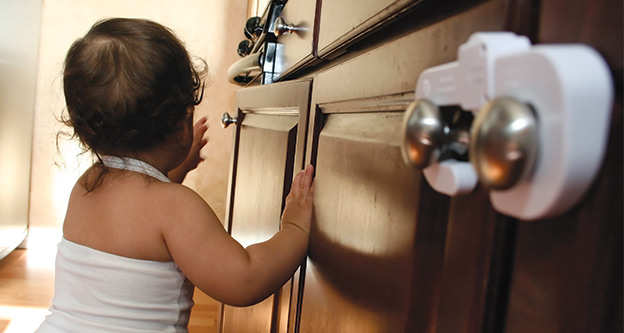
Section
Child Safety
You can help keep your child from getting hurt by watching her carefully and making your home safe for her to play and explore. Make sure relatives and others who care for your child also follow these safety tips.
Where to Find Help
Free, confidential help and advice about poisons 24 hours a day.
1-800-222-1222
Information and resources for missing and exploited children.
1-800-843-5678
Things You Can Do
Keep Your Home Safe
Put in smoke and carbon monoxide alarms and test them once a month. Change the batteries twice a year. It’s easy to remember if you change the batteries on the same day that you set your clocks forward or back.
Teach your toddler not to touch things that can be hot, like stoves, fireplaces, barbecues, and matches.
Keep small objects, sharp tools, balloons, and plastic bags out of your child’s reach.
Keep houseplants out of reach—many are poisonous.
Gun Safety
The safest home is one without a gun. If you have one, lock the unloaded gun in one place, and lock the ammunition somewhere else.
Use a child-resistant lock on the gun.
Ask about guns in other homes where your child spends time. Ask a responsible adult if guns in the home are stored securely.
Teach children never to touch a gun and to tell an adult right away if they see one.
Checklists
Home Safety Checklist
Use this checklist to make your home ready for your new baby.
Never Leave Small Children Alone in the Kitchen
Turn pot handles to the back of the stove.
Keep your child away from the stove when you cook.
Keep knives and other sharp utensils away from the edge of the counter.
Be careful with ironing boards and irons. Children can tip them over and get burned.
Put cleaning supplies, chemicals, and appliances in cabinets with safety latches.
Empty buckets right away. A child can drown in a few inches of water.
Never Leave Small Children Alone in the Bathroom
Keep a childproof knob on the door.
Keep medicines, razors, and personal care products in cabinets with safety latches. Keep medicines in their childproof packages.
To prevent burns, set the water heater at 120 degrees Fahrenheit. Test the water temperature with the inside of your wrist or a thermometer.
Use slip-proof mats inside and outside the tub.
Always drain the tub. Keep the toilet lid closed.
Unplug appliances and keep them out of reach, so your child cannot pull them into the water.
Safety for Preschoolers and Older Children
Know your child’s friends and the places and homes she visits.
Do not put your child’s name on the outside of her clothes or backpack.
Between ages 4 and 5, teach your child her full name, address, and phone number.
Teach her never to get in a car with a stranger.
Tell your child to say “no” if anyone tries to touch her or treats her in a way that scares or upsets her. Tell her to get away quickly and tell you or another trusted adult.

Put safe things, like pots and measuring cups, in drawers that your child can open. Put dangerous things, like knives or cleaning products, in cupboards with safety latches.
Safety in Your Neighborhood
Make sure you know where your child is at all times. Do not let your child play alone outside or in an unfenced yard. To prevent injuries, look for play equipment that has sand, wood chips, or rubber mats underneath.